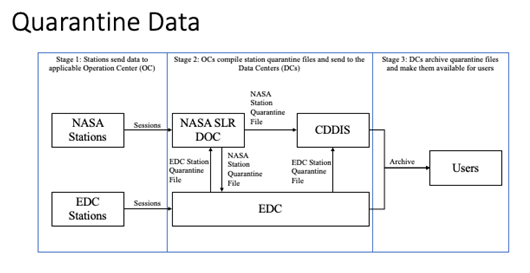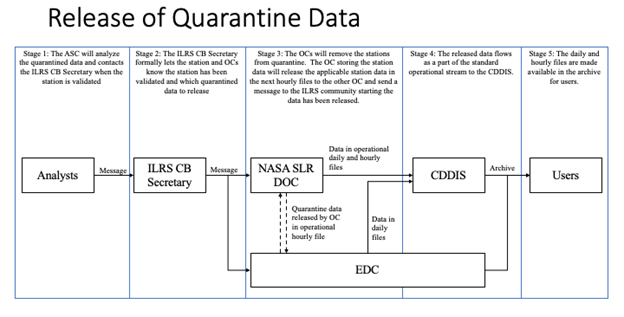Quick Links
- Network Map
- List of Stations
- Monthly Report Card
- Quarterly Report Card
- Network Status Page
- Potsdam CPF time bias service
- Procedure for estimating laser beam divergence
- Recent Station Upgrades
- Network station application form
- Revised ILRS station screening process at ILRS Operations Centers (NASA and EDC)
Procedures for SLR Data Quarantine
General Procedure for Data Quarantine
The ILRS Station Quarantine Procedure avoids transmission of questionable data (because of station upgrade or outage) from the stations into the operational data files until the Analysis Standing Committee (ASC) has verified the data. Therefore, ILRS Operations Centers (OCs) must hold the data outside of the operational data stream but deliver them instead to the ILRS Data Centers (DCs, CDDIS and EDC); the DCs will store the quarantined data in separate directory structure so that the data are available for the Analysis Standing Committee (ASC) to review and analyze. This procedure also allows us to keep track of stations that are undergoing significant maintenance or upgrades.
The following points explain the circumstances under which a station can be placed in quarantine and the steps that must be followed by the station and ILRS infrastructure:
- The OCs will move any station into quarantine if the station has not provided data for a period of 90 days;
- Stations may declare themselves in quarantine by informing their OC and the CB;
- Stations planning to be out of operation for any major maintenance or upgrade activity that could affect the data must inform the ILRS Central Bureau (CB) well ahead of the activity; they must also provide an estimated time for completion;
- Once initial notice is received, the CB, with guidance from the Analysis Standing Committee (ASC) and the CB's engineering personnel, will decide if quarantine is warranted;
- When in quarantine, stations should provide the CB and the ASC with monthly updates on their progress;
- Once stations are ready to return to normal operations:
- They should send a message informing the CB, including a description of any system changes made during the down time;
- They should update their configuration files, site log and configuration history log (as appropriate);
- Newly collected data which has been kept in quarantine must now be examined by the ASC
- The ASC will analyze the quarantined data and declare when data have been validated using the criteria of a minimum of 201 acceptable passes on each satellite (LAGEOS-1, LAGEOS-2, and LARES-1 and -2) within a 60-day sliding window;
1 Stations should collect more than the minimum 20 passes since during the analysis some of them will be rejected as outliers even if they looked valid at the station level.
- If the site is or aspires to be an ILRS core site, the station should strive for a standard deviation in the Normal Points to LAGEOS-1 and -2 and LARES-1 and -2 under 10 mm in standard deviation; in addition, they should also aim to minimize any systematic errors and their variability, such as range biases; the QC evaluation will focus on these parameters.
- The ASC will inform the CB when the station data have been validated; the CB will then notify the station and the NASA and the EDC OCs; the OCs will release the previously quarantined data with any caveats specified by the ASC (such as allowable time periods);
- The EDC (in consultation with the ASC and the ILRS CB) will maintain a tabulation of all quarantine periods by station.
Quarantine Procedure for Unique Situations
Some system changes may occur with a period of concurrent operation of the new and old configurations before data from the new configuration starts flowing through the operational channels. An example of this is the parallel operation of the Time Interval Unit (TIU) and the new Event Timer (ET) at MOBLAS-5 during the first half of 2017. The period of concurrent operation can provide a very powerful data set for comparison and evaluation while the old configuration data continue to flow through the Operations and Data Centers (OCs and DCs). Note: Although in the case of the TIU/ET transition, the passes and points are nearly identical, small differences in the data may occur; the ranges are not identical due to the improved RMS of the ET and the normal points can differ in number of included observations, rms, and range. When the Analysis Standing Committee (ASC) gives its approval, the station may begin sending the new configuration data (in this example, the new ET data set) rather than the old configuration data. The stations would notify the community of the transition, which should happen seamlessly. This procedure would apply to any transition that the Central Bureau (CB) deems would affect the ranging signal path:
- For information purposes, the station will inform the CB of the details of the system change and the planned schedule.
- The CB, in consultation with the ASC, will concur on whether the change warrants detailed examination.
- If examination is warranted, the station will continue to flow data using the old system configuration in the routine manner and file the new configuration data locally.
- The ASC will specify the span of data required for the examination.
- At the direction of the CB, the OCs will establish a file of these data (either in a quarantine or an engineering status) where the specified new configuration data are to be submitted.
- The station may submit the new configuration data into the file at its convenience and will alert the ASC and the CB when the data requirement has been fulfilled.
- The ASC will organize and conduct its evaluation and interact with the stations as necessary to expedite the process.
- The ASC will inform the CB when the station has passed the evaluation.
- The CB will notify the station to:
- transition to sending its new configuration data through the operational channels;
- update its configuration files, site log, and configuration history log (as appropriate); and
- inform the community of the time of transition.
- The CB will notify the NASA and the EDC OCs of the transition.
- The new configuration data files submitted for the evaluation process will remain available at the DCs for access by the general community for additional studies.
The situation presented above represents an example of a unique situation. For other circumstances, the station should coordinate with the CB and the ASC to determine, based on the facts, what are the appropriate steps to take, and properly document the facts and steps taken after the situation occurs.
If there are any questions, please contact your OC or the ILRS CB.


- NASA Official: Frank Lemoine
- Web Developers: 610 Web Dev
- Contact Us
- Last modified date: Mar 12, 2024
- Privacy Policy & Important Notices




